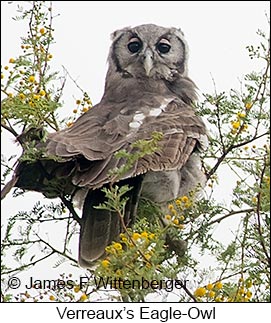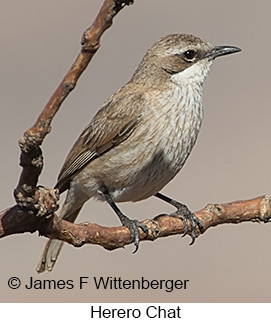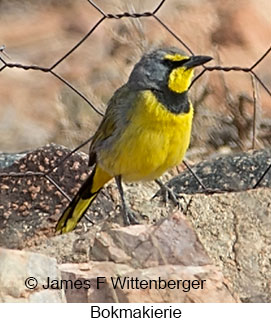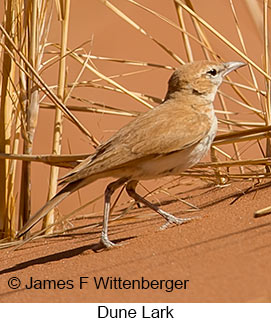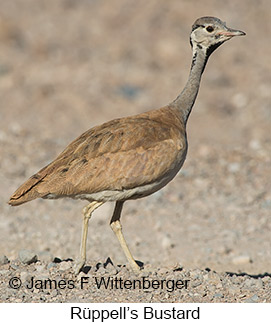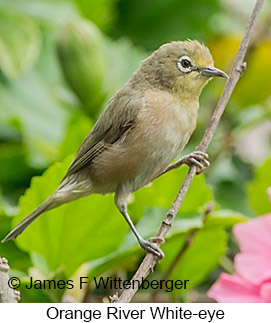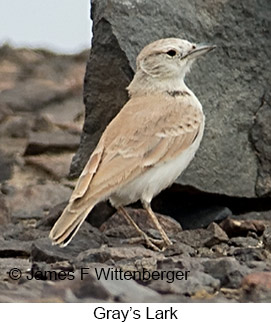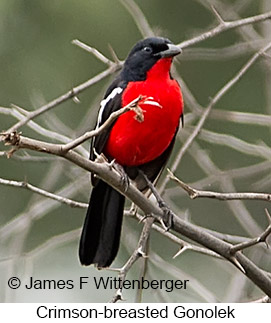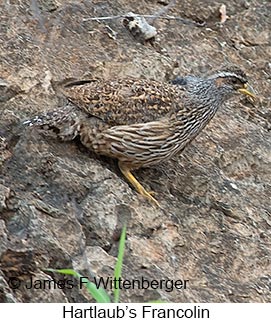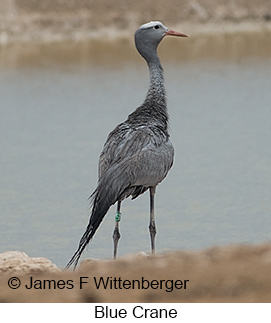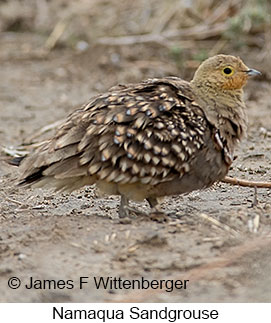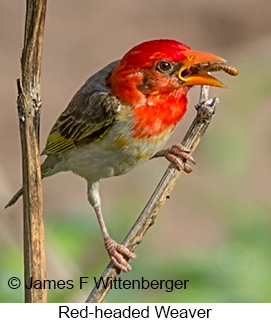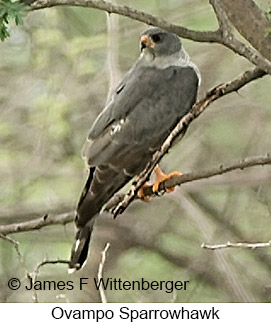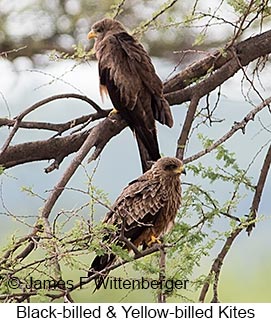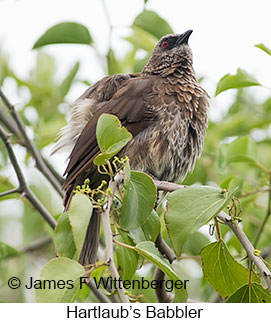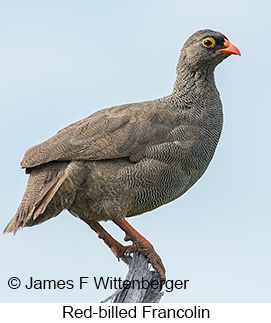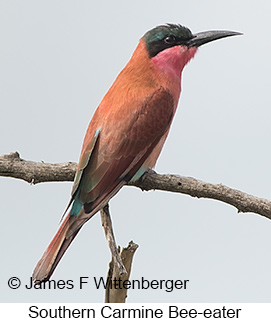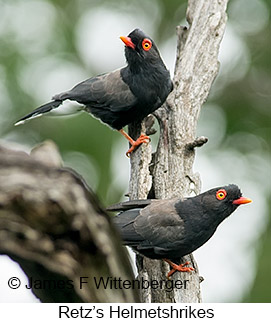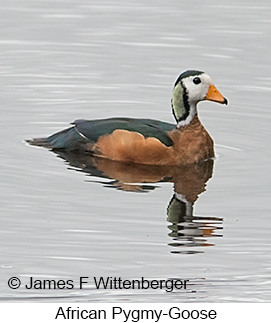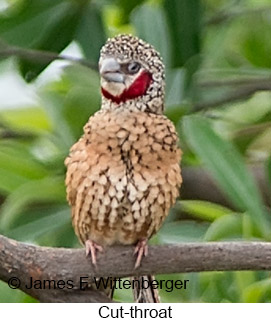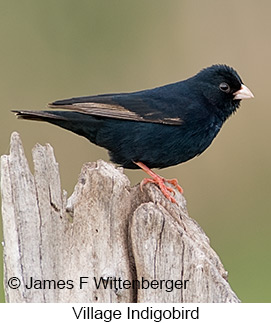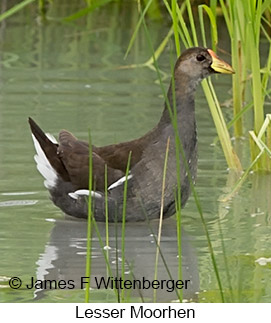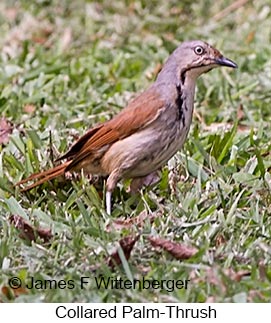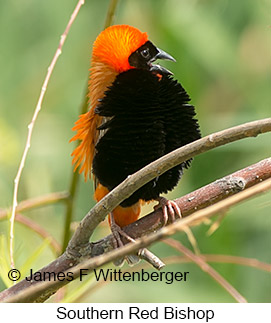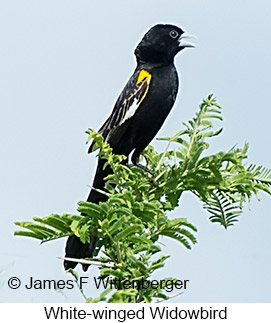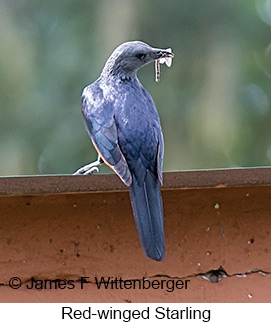NAMIBIA BIRDING TRIP REPORT

TRIP REPORT
NAMIBIA
| Start: | 01/04/2017 |
| End: | 01/28/2017 |
| Duration: | 25 days |
| #Species: | 407 |
| #Endemics: | 14 |
| #Heard Only: | 3 |
2017 Namibia Scouting Trip
TOUR DESCRIPTION
Namibia is the most politically stable country in Africa and is a fabulous birding destination. It features just two endemics (Damara Red-billed Hornbill and Dune Lark) but also an additional 31 near endemics shared with western South Africa or southern Angola. Namibia is the only country in the world where wild animals roam freely outside parks and reserves, making it very special in that regard.
My scouting trip was a complete success, with 407 species recorded compared to my guide's previous best of 377 for a 3 week trip during the 16 years he has been guiding birding tours. Moreover, his previous best included some 20 pelagics that are possible only by going out some 15-20 miles from Walvis Bay, which was not possible on my tour. Hence, we bettered his previous top result by some 50 species! Such success was made possible in part by the substantial rains occurring this year in Namibia, the best rains since 2011. The rains brought in a number of species that are only possible in years of good rains or are much more difficult to get in years of little rain. We also simply had phenomenal good fortune in finding virtually all the specialties possible with my itinerary. Due to the openness of most habitat in Namibia, we had very good looks at most species and numerous opportunities for photography.
Jan 4: I arrived in Windhoek from my connecting flight in Johannesburg at 4:15pm. Immediately after arrival, we birded around the airport, the only reliable place to pick up Orange River Francolin. Normally this bird can be seen well there, but it was not very responsive to playback and we only saw it flying. Earlier in the season it would come very close in response to playback but now during January it's caring for young and is not as territorial. Other notable birds seen at the airport included Little Swift, South African Swallow (our only sighting of the tour), Familiar Chat, Yellow Canary (also our only sighting of the tour), Southern Red Bishop, Black-faced Waxbill, Red-headed Finch, and Shaft-tailed Whydah. The airport is 38km outside Windhoek so we didn't arrive at the hotel until 6:30pm.Jan 5: We spent the early morning birding around the hotel for an hour. We had quite good bird activity among the Acacia trees along road. Some of the good ones seen were Little Sparrowhawk, which was chasing a Laughing Dove, Bradfield's Swift, White-rumped Swift, White-backed Mousebird, Pririt Batis, Icterine Warbler, Rufous-vented Warbler, and Groundscraper Thrush. After breakfast we went to the sewage ponds, which offer some very good wetland and edge habitat. One can drive around on dirt tracks among the settling ponds. Acacias and Eucalyptus line some of the tracks. Water levels were quite high, substantially reducing the number of shorebirds present. We were there until 12:30pm at ponds and picked up South African Shelduck, Hottentot Teal, Southern Pochard, White-Stork, Kori Bustard, Black Crake, Red-knobbed Coot, African Jacana, Ruff, Temminck;'s Stint, Swallow-tailed Bee-eater, Brubru, White-throated Swallow, Great Reed Warbler, Rattling Cisticola, Zitting Cisticola, Southern Red Bishop, Eastern Paradise-Whydah, and many others. We had a nice lunch at a caf� in Windhoek, where we saw Rosy-faced Lovebirds nearby, and then drove 20min to Daan Viljoen National Park. The park was privately funded and set aside by its namesake. It's now a national park. Game animals are present but predators are absent. The habitat is very dry bushland. We arrived at 3:15pm and drove down the road a ways from the lodge at 4:00pm. We had a brief rain shower followed around 5:30pm by a bit more rain. However, the creek bed running behind the lodge remained dry, as it has been for the past 5 years. Down in the creek bed we saw Red-billed Francolins, a common and widespread species. Across a gully we flushed a Verreaux's Eagle-Owl out of thick cover. It flew along the gully and perched in the open. Other notable birds seen were Dideric Cuckoo, Pearl-spotted Owlet, Monteiro's Hornbill, Crimson-breasted Gonolek, Short-toed Rock-Thrush, Scarlet-chested Sunbird, Golden-breasted Bunting, Red-billed Firefinch, and Pin-tailed Whydah. We were back at the lodge about 6:15pm.
Jan 6: Before breakfast we went out on game drive for an hour along the loop road. We saw good numbers of Gemsbok, several Giraffes (southern race), numerous Hartmann's Mountain Zebra (quite endangered 40 years ago but now well recovered), and many Steenbok. New bird species were Golden-tailed Woodpecker, Sabota Lark, and Lark-like Bunting. After breakfast we departed for Spreetshoogte Pass. The road is gravel, as is true throughout the coastal area and much of Namibia outside Windhoek. The road is brick in Spreetshoogte Pass itself, which is very helpful as the road there is quite steep. We reached Namibgrens Guesthouse at 2:35pm and went for a drive to the pass at 4:40pm. We drove half way down the pass looking for Herero Chat, our main target bird and typically difficult to find. It's uncommon and often unresponsive to playback once it's no longer mating. Mating is mainly Sep-Oct before many other birds are in breeding plumage. There was no sign of it and we got no response to playback. We did see our only Lesser Honeyguide of the tour. We also had good views of Bokmakierie, Karoo Scrub-Robin, Mountain Wheatear,, Violet-backed Starling, Cape Wagtail, and Cape Sparrow. After dinner we went out for a night drive and saw more Hartmann's Mountain Zebra. A highlight was two Common Genets that we picked up by eye shine as they were running on a ridge above us.
Jan 7: We departed at 6:30am for a drive along the dirt road toward Solitaire. We saw a nice Bontebok, a beautiful antelope introduced from South Africa. We also had very nice looks at Kalahari Scrub-Robin, Tractrac Chat, and Scaly Weaver. We also saw a rare dark morph of Pale Chanting Goshawk. There were many Springbok along the road plus a number of Gemsbok and a few Steenbok and Greater Kudu. All were very wary due to locals shooting at them. After breakfast we departed for the lowlands. We stopped just below the top of Spreetshoogte Pass and tried again for Herero Chat. We got a quick response to playback. The bird was perched far off and wouldn't come closer, so we scrambled up the rocks to get closer. While scrambling we had fine views of two Cardinal Woodpeckers. I circled around where I got quite close to the three Herero Chats for some excellent photos. In the same bush as the chats was a Layard's Warbler, an uncommon species often missed by birding groups. On the way back down had stunning views of Bokmakierie, a brightly colored shrike that stands out in a landscape of mostly drab browns, tans, and gray-greens. Also on the way back down we had a brief look at Cape Bunting. We then drove down the pass toward the coast. It's a fairly desolate arid land of dry scrub and very rocky soil with scattered farms owned by people trying to scratch out a living raising goats and horses. We managed to find one pair of R�ppell's Bustard, which is quite uncommon, and had good views of Namaqua Sandgrouse, Pygmy Falcon, Rock Kestrel, Greater Kestrel, and Dusky Sunbird. We reached Sossusvlei about 12:30pm. At the entrance are massive nests of Social Weavers. These nest structures can be over 100 years old and are reused every year until they collapse and fall to the ground. They house many individual nest holes accessed through the bottom of the structure. In the afternoon we hiked through Seisem Canyon, carved out of a tectonic fault line by an intermittently flowing river that rushes through after heavy rains. The canyon is narrow and about 30m deep. One can see layers heavily laden with gravel, marking periods of heavy rains, intermixed with layers of little gravel and mostly compressed sand that are laid down during dry spells. A Barn Owl nests there at times, evidenced by a feather we found, but we didn't see it.
Jan 8: We were up at 4:30am and departed at 5:00am for a drive into the dunes area. Only people staying inside the park at the Sossus Dunes Lodge or the campground near the entrance can reach the dunes before dawn because the park gate is closed until later. Some people staying outside the park leave their vehicles parked inside the gate and sneak in from nearby lodges outside the gate. We reached a parking area after 30min drive by tarmac road into the dunes area. We then transferred to a 4x4 vehicle for the last 6km drive along a sandy track than normal vehicles can't manage. From there we hiked up to a quite massive dune, though not the largest (which is 325m high), and then along a knife edge crest of the dune where we could take photos of the sun coming up over the dunes. Walking is quite difficult in the loose sand, but the very crest of the dunes is more compacted and somewhat easier going. Unfortunately the ripples in the sand from prevailing winds were on the wrong side from the sun so I couldn't get the stunning photos one sees in magazines. It was still a memorable experience. After the sun was up we clambered/skidded down the side of the dune to a hard limestone pan below where an 800-year-old "forest" of dead trees provided numerous photo ops. As the morning heated up, we hiked back to the parking lot, transferred back to our vehicle via 4x4, and went looking for one of Namibia's only two endemics, the Dune Lark. This lark likes dunes with clumps of dune grass. We stopped at a likely spot and quickly spotted a pair responding to playback. The bird first sang from within a clump of grass. It then dropped to the ground and went running, not hopping, off. We were able to get some good photos. After that we returned to the camp entrance where we had an early lunch at the bar/restaurant, arriving by 10:10am. During the day it's too hot for much activity, so we rested until 5:30pm, when we went back out to look for coursers. It was very windy so bird activity was low. We tried for Dune Lark again with no success and drove the roads looking for coursers and bustards without success. Finally, on the way back we spotted a young male Ludwig's Bustard, a good bird since the species is nomadic and often difficult to find. We also saw a male Pygmy Falcon perched on a bush facing into the wind and trying to maintain its perch. We were back at the lodge by 7:10pm.
Jan 9: At 6:00am we drove out to some separate dunes in the opposite direction from where we were the previous afternoon. I was able to get some nice photos of the dunes at first light. We again saw Dune Lark and also Pale Chanting Goshawk. We clambered up the side of a rocky ridge where we saw Pied Barbet, Cape Crombec, and our only Rockrunner of the tour. After 7:30am breakfast we departed for Walvis Bay, looking for coursers along the way. None were seen. We did see Black-breasted Snake-Eagle, several more Ludwig's Bustards, R�ppell's Bustard, and Greater Kestrel. The last hour and a quarter is through very arid desert plains. After arrival and check-in at our B&B in Walvis Bay, we went birding along coastal mudflats of the bay. The tide was partially out, and lots of Greater Flamingos and Lesser Flamingos were feeding in the shallow water. Other birds included Cape Teal, Three-banded Plover, White-fronted Plover, Chestnut-banded Plover, Bar-tailed Godwit, Hartlaub's Gull, Damara Tern, and various other wetland birds. We were back to hotel by 5:45pm.
Jan 10: Before breakfast we saw two Orange River White-eyes in the garden behind our lodge. After breakfast we went out on a boat in the harbor. Seas were a bit rough for the harbor area. We saw a couple Crowned Cormorants and many Cape Cormorants but no Bank Cormorants. We also saw a young Cape (African (Jackass)) Penguin hanging out under an oil platform brought down from Angola for maintenance. To get the seabirds, one must go out at least 15-20 miles, which requires a group of at least 4 people to cover the cost of the boat. We failed to see the Benguela Dolphins, which were not present due to sea water temperatures in the harbor. We did see many Brown Fur Seals on a breeding rookery at Pelican Point. We also saw a couple African Oystercatchers, several Great White Pelicans, Kelp Gulls, Hartlaub Gulls, Common Terns, and Sandwich Terns. Back from the boat trip we found a couple Gray-headed Gulls mixed in among numerous Hartlaub's Gulls. Along the waterfront we found our only Cape Shoveler of the tour. That afternoon in town near the B&B we found Red-faced Mousebird, Marsh Warbler, and better views of Orange River White-eyes.
Jan 11: After 7:00am breakfast we departed for Swakopmund. Our main target birds there were Bank Cormorant, a quite scarce species at the northern end of its range, and Gray's Lark. The habitat is stark, flat arid plain with scattered low bushy plants around the Salt Works plus a coastal area with sandy beaches and a wetland. A large pier is set up for nesting Cape Cormorants for the purpose of harvesting guano. Probably a million Cape Cormorants were present, at this time commuting between nests and the open sea in substantial flocks while feeding young. Sometimes one or two Bank Cormorants will be present on dunes, but none were present this day. We did see a small number of Great Cormorants along with both species of flamingos, perhaps a hundred Sandwich Terns and Caspian Terns, plus a few Damara Terns. We drove all around the dry plain looking for Gray's Larks. Sometimes they're absent because they had been pushed out by Red-capped Larks, but we didn't see any larks at all. Perhaps it was so dry after 5 years of drought, that insects, and hence larks, were having a hard time of it. We then drove to Spitzkoppe, looking for larks en route. We had good luck and soon found Gray's Lark and Red-capped Lark sitting together along the side of the road. We were also keeping an eye out for Burchell's Coursers, as this section of road was our last chance for this nomadic species. No luck with them. We did see a few R�ppell's Bustards sheltering in the shade of small bushes. At Spitzkoppe we finally saw Southern Fiscals, strangely absent earlier in the tour. After lunch at the small caf� inside the entrance to the conservation area, we drove part of the loop road and soon found 3 Herero Chats. Amazingly, we saw 6 total on the tour counting the 3 seen earlier, which is highly unusual. We also had the good fortune of seeing a pair of White-tailed Shrikes in the same area. This species is often missed on birding tours. In addition, we picked up Swallow-tailed Bee-eater, a couple Pied Barbets, Yellow-bellied Eremomela, Chat Flycatcher, and Tractrac Chat. From Spitzkoppe we continued on to the Erongo Mountains, arriving about 5:00pm. We stayed at the Ai Aiba Lodge as the Erongo Wilderness Lodge was closed for renovation.
Jan 12: We were up at 6:00am to look for Hartlaub's Francolin, which is only seen around there shortly after first light. It has to be calling to find it. We had no luck with it. Earlier in the season it's easier. We spent an hour birding around the lodge in dry Acacia bush. Interesting birds included Pearl-spotted Owlet, Red-faced Mousebird, Monteiro's Hornbill, Rosy-faced Lovebird (seen by the guide only), Ashy Tit, Yellow-bellied Eremomela, Rufous-vented Warbler, Violet-backed Starling, Dusky Sunbird, and White-throated Canary. After 7:30am breakfast we departed for Waterberg Plateau. On the way out we saw a melanistic Slender Mongoose run across the road, the first one the guide has seen in 15 years, several Damara Dikdik and a Bush Duiker. We also saw a distant Verreaux's Eagle, White-tailed Shrike, and Brubru. En route to Otjiwarongo we picked up Rufous-crowned Roller. At the Otjiwarongo Sewage Ponds we had good views of White-faced Whistling Duck, Southern Pochard, Little Grebe, including a baby and a floating nest with a single egg in it, Sacred Ibis, Eurasian Moorhen, Whiskered Tern, Namaqua Dove, and Marsh Warbler. After lunch we drove to Waterberg. In a good year many raptors are present on telephone poles. But, after 5 years of drought they were largely absent. We did finally see a soaring Brown Snake-Eagle. At the beginning of the gravel road into Waterberg, we saw a Common Buzzard in flight. We had brief views of a perched Diderik Cuckoo but were quickly distracted by a wintering Amur Falcon perched atop a dead tree, very unusual for this area. We had our first look of R�ppell's Parrot, good views of African Gray Hornbill, and Burchell's Starling. In a single spot we found two colonies of Chestnut Weavers actively building nests and also Pied Cuckoo, Swallow-tailed Bee-eater, Barred Wren-Warbler, Kalahari Scrub-Robin, and Green-winged Pytilia. After arrival at Waterberg, we drove around the campsite and accommodation bungalows. We quickly found an African Gray Hornbill. At one spot we picked up African Hoopoe, Common Scimitarbill, Damara Red-billed Hornbill, Black-backed Puffback, Crimson-breasted Gonolek, Fork-tailed Drongo, Gray-backed Camaroptera, Red-backed Scrub-Robin, Burchell's Starling, Mariqua Sunbird, Violet-eared Waxbill, and Green-winged Pytilia. We had decent views of Pied Cuckoo. A bit later we found a Pied Barbet , pair of Golden-tailed Woodpeckers, a pair of Pririt Batis, and White-bellied Sunbird. We saw many Damara Dikdiks along the entrance road.
Jan 13: It started raining at 3:00am and was still raining by morning. With rain and fog birds were inactive so we ate breakfast and left. The clay and gravel road was quite slick with sometimes substantial water in potholes and in low spots but we made it to the main highway ok. We drove to Etosha National Park with birding en route. At a place north of Outje we stopped at some likely looking habitat and tried for Hartlaub's Francolin. We missed this bird at Erongo and again at Waterberg so figured we had no chance for it, especially since it normally only calls around dawn. Nevertheless, we gave it a try at this new spot the guide had never checked before and got an immediate response even though it was after 10:30am! With some effort we had stellar views of both male and female and got good photos of both. The guide said he'd never seen them so close before. We continued north toward Etosha, picking up Red-crested Bustard, Rufous-crowned Roller, African Paradise-Flycatcher, and Golden-breasted Bunting along the way. We stopped for lunch at the very nice Toshari Lodge, where we walked the grounds looking for Carp's Tit with no success. Once in Etosha we drove a number of roads and checked several waterholes around Halali. We got light rain, causing some concern that animals wouldn't come in to the waterhole by the lodge around dark. This part of Etosha is quite dry, though there were some green patches and many Acacia bushes were green. Some areas were desolate gravel plain with very little vegetation at all. Animals are scarce but we did see Plains Zebra, Hartmann's Mountain Zebra, Giraffe, Blue Wildebeest, and Greater Kudu. Certainly highlights were Rufous-eared Warbler, which came in nicely to playback, a group of the striking Black-faced Impala that included a young buck challenging an older buck, offering a nice photo op as they clashed antlers, a perched Martial Eagle crouched down looking for prey, nice views of Brown Snake-Eagle, and a female Spotted Hyena we spotted while looking at a Blue Crane that eventually crossed the road in front of us. We reached the lodge about 5:30pm and after 7:00pm dinner we went down to the waterhole behind the lodge. On the way we spotted a Great Spotted Cuckoo in a tree by the parking area. At the waterhole we saw a spectacular sunset over the water and a double rainbow in the mist behind us. It was a great photo op that I missed because I didn't have my wide angle lens with me. We had nice scope views of a pair of Double-banded Sandgrouse that landed on the near shore. The rest of the flock was quite distant on the far shore. We also saw several Fiery-necked Nightjars hawking insects nearby. No mammals showed up by 8:30pm so we called it a day. The waterholes at Etosha are great for mammals during dry season, but they don't usually appear when water is everywhere after good rains.
Jan 14: We were out for game drive at 6:00am in the western, more arid section of Etosha. Larks and coursers were few and far between but we finally picked up Eastern Clapper Lark and then a pair of Double-banded Coursers. After breakfast we departed for Halali, birding en route. We saw African Harrier-Hawk, White-quilled Bustard, Temminck's Courser, Namaqua Sandgrouse, Greater Kestrel, Sabota Lark, Monotonous Lark, Stark's Lark, Desert Cisticola, Chat Flycatcher, and Red-headed Finch en route. We arrived at Halali in time for lunch. Just outside the entrance we saw and photographed Cinnamon-breasted Buntings. Around the lodge we found a family group of young Violet Wood-Hoopoes. Most were still dull brown though one was bright violet though still lacking red bill. They were quite shy and flew away in response to playback instead of coming closer. Just outside the restaurant was a roosting African Scops-Owl hiding in a tree. Near the parking area we saw an immature Little Sparrowhawk in a tree and found several Pale-faced Babblers feeding on the ground. We planned on going out again at 3:30pm but some thunder and rain caused us to delay birding for a half hour. When we finally did, we finally found Carp's Tit. Bird activity was low and that was the only highlight.
Jan 15: We went birding around the lodge at 6:30am. The rain had stopped and it was partly sunny. We went looking for the Violet Woodhoopoes seen the day before and eventually found them. They remained uncooperative for photography. We then tried to find Carp's Tit again for better views. It was nowhere to be found. After breakfast we drove to Mokuti Lodge, arriving about noon. Thanks to the rain pools of water were everywhere, even in many parts of the Etosha pan. It was the first water in Etosha pan in 5 years. We saw numerous Greater Flamingos and also some Lesser Flamingos. Mammals were few and far between, now dispersed over a large area due to the rain. We did find a family of Bat-eared Foxes with 4 pups and some Red Hartebeest. We also saw a nice group of Common Ostrich that included a male, two females, and 16 chicks. Other species seen en route included White-headed Vulture, Brown Snake-Eagle, Kori Bustard, Greater Painted-Snipe (our only one of the trip), Double-banded Courser, Lesser Gray Shrike, Rufous-naped Lark, Spotted Flycatcher, Violet-backed Starling, and Chestnut Weaver. After arrival and check-in, we tried to find Black-cheeked Babblers. This spot is one of the few places to find them. When the area is dry, the babblers are usually easily found on the grass around the lodge. However, they disperse after it rains, and we found none. We did find Red-headed Weavers for stunning views. At 3:30pm we tried again for the babblers, again with no success. Then we drove back into the park. By 4:00pm it was raining heavily and continued raining for most of the next hour. The Etosha Pan, which has been dry for 5 years, was filling with water in large expanses, as were all the low spots along the road and across the plains. It was very wet everywhere. We saw several huge Etosha Bullfrogs on the road, which emerge only during the rains. We saw our first Marabou Storks, which were finding plentiful food thanks to the rains. As we headed back towards the lodge we encountered a mother Cheetah and her ¾ grown cub on a fresh Springbok kill. We spent the next half hour watching them devour the carcass and then clean each other before finally ambling off into the bush. The kill was only about 5m off the road, which allowed for easy photography from our vehicle. We were very fortunate to find the kill, which had happened about 20min earlier, as we were on a loop road and would have missed it if we'd gone in the opposite direction from the one we took. The few people who saw the kill said the mother Cheetah had ambushed the Springbok on the road and took it down without any chase. By the time the Cheetahs left, it was about 5:45pm so we drove back to our lodge outside the park entrance, arriving about 6:05pm.
Jan 16: We departed the lodge at 6:45 for another drive through Etosha. The eastern half of the park is much greener than the western side. We saw a very large pack of 16 Spotted Hyenas in fairly thick bush next to the road. Most notable among birds were Steppe Eagle (our only sighting during the tour), a pair of Ovambo Sparrowhawks (only the second sighting for my guide ever), Burchell's Sandgrouse on the road (normally only seen when coming to waterholes, which they don't do when there is water everywhere), Lesser Kestrel (nomadic), Lanner Falcon, Fawn-colored Lark, Flappet Lark, Wattled Starling (only sighting during the tour), and Cutthroat (first time my guide ever saw it in park - he normally gets one or two in the Caprivi area). Other interesting birds included Swainson's Francolin, Lappet-faced Vulture, Bateleur, Red-crested Bustard, Temminck's Courser, Rattling Cisticola, Violet-eared Waxbill, and Eastern Paradise-Whydah. In late afternoon we went back out and found Crested Francolin, Black-winged Pratincole (our only sighting during the tour), Kittlitz's Plover, and Southern Pied-Babblers (also our only sighting of the tour). In addition, we saw two very small Spotted Hyena pups that quickly ran back to their den and hid, along with an adult and subadult female.
Jan 17: After 6:30 breakfast we birded the lodge grounds. Our main target bird was still Black-faced Babbler, normally reliable and responsive to playback. As we were viewing other birds such as Black Cuckoo and Pied Cuckoo, we heard the babblers just once calling not far away. We quickly found a group of 5 in a tree back in the dry forest behind the lodge, where we had good views. We then brought in an African Golden Oriole with playback. Nearby we had a variety of species perch near us when we played Pearl-spotted Owlet calls, including Black Cuckoo and Pied Cuckoo again. In the same area we saw Gray Go-away-bird, Common Scimitarbill, Fork-tailed Drongo, a male African Paradise-Flycatcher perching nearby and feeding on the ground by a termite mound, Yellow-bellied Bulbul, Violet-backed Starling, Southern Gray-headed Sparrow, Southern Cordonbleu, and a female Green-winged Pytilia. We then departed the lodge for Rundu. En route we saw Lesser Kestrel perched in a palm tree and White-crowned Shrike. We also rescued a Flap-necked Chameleon that blended in quite well with the tarmac of the road. Outside Rundu on our way to the lodge we had excellent views of Magpie Shrike and Village Indigobird perching on a fence post. We had a nice view of Yellow-billed Kite and Black Kite perched together in a tree, allowing easy comparison of the two. At the lodge entrance we picked up Kurrichane Thrush, often a challenge to see. We arrived at the lodge about 3:00pm. After a half hour break we went birding around the grounds. We mainly birded the marshy area along the Okavango River by the lodge. Numerous Village Weavers were nesting there. Several Southern Brown-throated Weavers were also nesting. The guide said he usually has to work very hard to see them and never gets them so easily behind the lodge. We also saw a Spectacled Weaver, another tough weaver to pick up, and several Holub's Golden-Weavers. We saw numerous Lesser Swamp Warblers for good photo ops that were more responsive than usual. A single Sedge Warbler put in an appearance, a bird my guide hadn't seen in 5 years. Several Blue-eared Bee-eaters were perched on the reeds for nice photo ops and more were hawking insects over the river. A Little Bee-eater also perched briefly in the reeds. Amazingly, an Allen's Gallinule popped up and began feeding in a somewhat open area that gave us superb scope views of this normally very difficult bird to see. We also saw a Little Bittern that flushed from the reeds and a Woodland Kingfisher that perched on the old boat dock. Several Hartlaub's Babblers displayed nicely and more were flying around near the lodge. Two Swamp Boubous were feeding on the grass near the lodge, and a Red-billed Francolin perched on the railing of the dining area and began calling. Just as we were leaving to go to our rooms, two African Pygmy-Geese flew past along the reeds going down river. This species is usually very difficult to find but were nesting not far from the lodge in trees along the river bank. At the same time another Little Bittern flushed briefly before disappearing back into the reeds. The whole experience was quite extraordinary.
Jan 18: We woke to a light drizzle but went birding anyway at 6:30am. Due to the drizzle, I left camera behind. Of course, the drizzle stopped and photo ops began so I went back for my camera. While I was doing that, the guide saw a Rufous-bellied Heron flying along the river, which I missed. We both did see other birds along the river. Most notable was a melanistic Black Goshawk soaring over the river, a bird slightly out of its range or on the very edge of it. I also saw a very nice male African Paradise-Flycatcher near my room. After 7:30am breakfast we departed for Xaro Lodge in the Okavango Delta of Botswana. We kept an eye out for interesting birds en route. We saw a distant Dark Chanting-Goshawk as it flew away from us. We stopped to view some Meyer's Parrots and saw in the same spot an African Cuckoo-Hawk, a bird seldom seen by birding groups. We also saw a perched Shikra that was soon chased away by a Southern Yellow-billed Hornbill. Farther down the road we picked up a group of Arrow-marked Babblers that responded nicely to playback. We stopped at Popa Falls Resort for lunch but did no birding there as it was raining and we would be coming back there in a couple days. We continued toward the Botswana border, driving through the Mahango section of Bwabwata National Park. Along the road we had nice views of Southern Carmine Bee-eaters and more distant, backlit views of Green Woodhoopoes. After crossing the border into Botswana, we saw numerous donkeys that the local villagers presumably use for transport and sometimes pulling plow. We soon saw a Yellow-billed Oxpecker on one of them. A bit farther down the road we saw a Ground Hornbill in the fork of a tree trunk, evidently guarding a nest in the tree. We saw several White-fronted Bee-eaters and Blue-cheeked Bee-eaters. We arrived at the reception area of Drotsky's Lodge at 3:30pm. From there we took a boat to Xaro Lodge, located a half hour down river. We spent an hour and a quarter on the boat to do some birding along the way. Notable birds we picked up from the boat were a pair of African Pygmy-Geese, African Fish-Eagle, and Fan-tailed Widowbird. We also saw a number of Vervet Monkeys hanging around boat docks.
Jan 19: At 6:30am we went for a birding walk around the lodge. Our main target bird was Pel's Fishing Owl, a normally difficult bird to see and perhaps easiest to see at Xaro Lodge. We soon found a 2-year-old juvenile that was reasonably cooperative for photos. We also saw an adult 3 times, but every time it would fly before we could get good views of it. Also of interest were two Retz's Helmetshrikes that were very responsive to playback. A Crested Barbet came in to playback as well, allowing for a brief good look but no photos. After breakfast we went out on a boat up the Okavango River. Our boatman had seen a Sitatunga on his way to pick us up, but we could never find this rare antelope again. We had good views of African Pygmy-Geese that are nesting in a small channel between the Papyrus beds and the shoreline near the lodge plus a few Grosbeak Weavers in the same Papyrus beds. Also present were numerous Village Weavers and fewer Southern Brown-throated Weavers. Farther upriver we found two White-backed Night-Herons roosting deep in foliage along the shoreline. This very difficult species is regularly located by our local guide at Xaro Lodge but is generally not easy to see. We saw numerous Little Bee-eaters, large numbers of Plain-breasted Martins roosting in the Papyrus beds along with a few Sand Martins, many Blacksmith Lapwings, and a couple Long-toed Lapwings. We saw a number of strikingly colored, diminutive Malachite Kingfishers and a couple Pied Kingfishers. We had very good views of several African Fish-Eagles perched along the river. We saw several Spur-winged Geese in flight but never on the water. In the Papyrus beds were good numbers of Lesser Masked Weavers, a few Southern Brown-throated Weavers, and a few Fan-tailed Widowbirds. We saw a couple Coppery-tailed Coucals, always wary and not easily approached. We saw a couple Goliath Herons from a distance. We had good views of several Lesser Jacanas in flight. These birds are very shy and stick to thick vegetation. We saw several Water Thick-knees amongst many Blacksmith Lapwings. Three African Clawless Otters briefly showed before disappearing into the reeds. We had overcast skies and several rain squalls during the morning. The water levels were fairly high and rising as it's been a good year for rains so far. After lunch we went out again for a short period to look for African Finfoot, which had been reported recently near the lodge. We didn't find any but did have good views of a Giant Kingfisher. At 4:00pm we went birding around the lodge. It was partly sunny but clouds soon rolled back in. We had backlit views of an adult Broad-billed Roller and better views of an immature. We had nice views of Black-collared Barbet, Golden-tailed Woodpecker, and Narina Trogon. We saw several Bushbuck while walking around. After wandering around on trails, we encountered a good sized flock of African Green-Pigeons in a true, mostly backlit. While standing there an adult Pel's Fishing-Owl flew out of the same tree (to our great surprise!). We found it again a bit farther down the trail and finally had good looks of it perched in a tree. Shortly thereafter we saw a Goliath Heron in flight over the marsh. We were back at the lodge about 6:30pm.
Jan 20: I was up at 6:30am to get better photos of African Pygmy-Geese and Grosbeak Weavers and had good success. At 7:00am we went birding around the lodge grounds. Interesting species were Red-faced Mousebird, Narina Trogon (again but never posing for photos), Terrestrial Brownbul, Yellow-breasted Apalis, Chirping Cisticola, and Collared Sunbird. At 9:15am we departed by boat to return to our car. We quickly spotted a Giant Kingfisher perched nicely in the open. We stopped en route to pick up Greater Swamp Warbler. We tried for White-backed Night-Heron in the same spot we'd seen it the day before. It wasn't there. We then drove to the Botswana-Namibia border. We reached Popa Falls Resort in time for lunch. At 3:00pm we went into the Cape Buffalo Reserve, part of Bwabwata National Park. We quickly found White-winged Widowbird, a bird seldom seen by my guide. In the park we saw Swainson's Francolin, Gray-headed Kingfisher (only sighting for the tour), European Bee-eater, Black-faced Babbler, andRed-billed Oxpecker. We hoped to find storks, but water levels were too high for them. We did have very nice views of two Sable. The main reason for visiting this reserve was to look for African Wild Dogs, which are regularly seen there but are always difficult. We didn't see any. We arrived back at the lodge about 6:45pm. During dinner my guide spotted a White-backed Night-Heron perched in the same place along the river where he'd seen it the previous month with another group. Unfortunately, it flew immediately so I missed it.
Jan 21: After 6:30am breakfast we departed for Mahango section of Bwabwata National Park. The habitat was thick and lush, especially after the heavy rains. This section also offers a small possibility of seeing African Wild Dogs. We saw none. We hoped to see Saddlebilled Storks and Wattled Cranes, but water levels were substantially above normal due to the recent rains and neither were in evidence. The most notable birds seen were Senegal Coucal, Bradfield's Hornbill, Southern Black-Tit, and Northern Gray-headed Sparrow. Notable mammals were Red Lechwe, Southern Reedbuck, and Common Tsessebe. The latter was a single individual, which ran off almost immediately when we stopped the car. This species is typically quite wary of people. The Red Lechwe were in quite large herds, and we saw several clashes between males. We also saw numerous Common Impala including a good sized bachelor herd. In the afternoon we went back out to the game reserve. Our main target bird was Bronze-winged Courser, a nocturnal species that sometimes appears along the track in early evening. Unfortunately, it did not appear this time. We did see Marabou Stork, Black Heron, Brown Snake-Eagle, Collared Pratincole, Brown-crowned Tchagra, and Cut-throat.
Jan 22: We were up at 6:30am for some birding around the lodge. There was a light drizzle that soon turned to rain. We did have good views of Terrestrial Brownbul and White-browed Robin-Chat. After 7:00am breakfast we departed for eastern Caprivi area. En route we had good views of Meyer's Parrots. We were able to call in a Green-capped Eremomela that responded to Rufous-bellied Tit playback plus a pair of Tinkling Cisticolas. We had distant scope views of Lesser Spotted Eagle.Farther along the road we were lucky enough to find three Dickinson's Kestrels perched in a dead tree some distance from the road. My guide has never seen 3 of them together before, and he only sees them about 20% of the time. We had good views of a male, female, and fully grown young. Rain had dogged us off and on along the road and soon caught up to us where the kestrels were perched. Even so, I was able to get some distant photos of them. A bit farther along the road we found Shaft-taIled Whydah showing nicely. In the same place we saw Yellow-fronted Canary, Village Indigobird, and Eastern Paradise-Whydah. A bit farther along the road we had good views of a perched Steppe Eagle, a soaring Brown Snake-Eagle, and a pair of soaring Lappet-faced Vultures. We arrived at Namushasha Lodge at 12:15 in time for lunch. At 3:00pm we went out on a boat trip along the Kavango River. We saw several Water Thick-knees. Even better, we saw two Slaty Egrets, always very difficult, plus four Rufous-bellied Herons, also difficult. That was followed by a fly-by of another Rufous-bellied Heron in good light. Then we picked up our only Saddlebilled Storks of the tour. To top the afternoon off, we had good views of several Luapula Cisticolas.
Jan 23: At 6:30am we did some birding around Namushasha Lodge. There we saw African Green-Pigeon, Cardinal Woodpecker, Common House-Martin, Greater Blue-eared Starling, Yellow-billed Oxpecker, Collared Sunbird, Holub's Golden-Weaver, and Brown Firefinch. After breakfast we went on a game drive in Bwabwata National Park in hopes of seeing African Wild Dogs. The chances were very slim as vegetation was lush, grass was tall, and water was everywhere so all animals were dispersed instead of concentrating along the river. We didn't see any predators. We did pick up a interesting birds including White-backed Vulture, a young Martial Eagle, Long-crested Eagle, Gray-headed Kingfisher, Striped Kingfisher, Racket-tailed Roller, and Red-billed Firefinch. We were back at the lodge by 11:30am. At 3:00pm we went back out on another game drive in the national park, again hoping for Leopards or African Wild Dogs. We saw neither. Just as we got on the boat that took us down river to the vehicles, it began to rain. Fortunately, the rain stopped a few minutes later when we transferred to our 4x4. We saw very little in the way of new birds until we reached almost the farthest point of our drive. There we found a Levaillants Cuckoo that showed nicely. Just a bit farther down the road we saw two adult and one juvenile Wattled Cranes. They were very far but we had decent scope views. On the way back we heard a Lesser Moorhen. As we drove through flooding on the track, it flushed and scittered across the road for a quite brief view of this normally difficult to see species.
Jan 24: At 5:30am we drove back to the main highway through Bwabwata National Park. We hoped to see African Wild Dogs, a long shot. On the dirt road toward the highway we saw two Fiery-necked Nightjars and a number of Blacksmith Lapwings and Wattled Lapwings. Along the tarmac on the main highway through the park we saw a Spotted Hyena feeding off some garbage thrown on the side of the road. Some 10km farther down the road we saw two Cheetahs lying in the dirt near the road. The first one we saw was reluctant to leave. We soon discovered why. His brother was also near the road but had an injured front forepaw. Both eventually moved farther off the road and into the bush. On our drive back we went down a dirt side track off the highway and found four Common Tsessebes that soon ran into the bush. Back on the main road we saw several Whire-crowned Shrikes, at first heard but then seen well when they landed in a tree near the road in response to playback. They are truly stunning birds. A bit farther along we saw two Coppery-tailed Coucals perched not far from the road along with a herd of some 15-20 Waterbuck in the savanna fairly close to the road. On the access road back to the lodge we saw a couple Amethyst Sunbirds. We left for Katima Mulilo about 9:00am after breakfast. Not far outside town we stopped at a wetland in hopes of seeing Yellow-crowned Bishop. We were quickly rewarded with a stunning male displaying in flight over the wetland and perching in nearby bushes. We then heard Lesser Moorhens in the flooded grass. They soon appeared in response to playback. We had amazing views of two adults and a young male feeding fairly close in flooded grass. We spent the next hour trying to photograph this normally secretive species and eventually got a couple good photos. In town we stopped for lunch at the Protea Hotel along the Zambezi River before continuing to Caprivi River Lodge, also along the river. At the latter lodge we soon saw a Schalow's Turaco perched below the canopy of a large tree, posing nicely for photos. This species has a disjunct local population separate from those in East Africa. At 4:00pm we went on a 2½ hour boat trip on the Zambezi River. We had quite amazing views of African Finfoot and White-backed Night-Heron, both in the open long enough to obtain photographs. We saw 4 African Finfoot in all, but the first two were the most open. We also had a perched Western Snake-Eagle, White-crowned Lapwings, Brown-hooded Kingfisher, Giant Kingfisher, and Trumpeter Hornbills. The very sought-after Half-collared Kingfisher and Pygmy Kingfisher, the latter never seen by my guide, are quite possible along the river but missed this time.
Jan 25: We spent an hour starting at 6:30am birding around the lodge. New birds of interest were Hadada Ibis, Yellow-fronted Tinkerbird, Sulphur-breasted Bushshrike, Ashy Flycatcher, and Bronze Mannikin. After breakfast we departed for Botswana and Chobe National Park. En route we picked up African Hawk-Eagle (soaring high overhead), Lesser Moorhen (again seen well and even more in the open), Pied Cuckoo, Striped Kingfisher, Icterine Warbler, and Miombo Wren-Warbler. We arrived at 12:30pm and took a break for lunch. At 3:30pm we went to a nearby lodge where Collared Palm-Thrush is usually easier than at Chobi Safari Lodge. We eventually had very good views of this somewhat shy species. In late afternoon back at the lodge we heard a racket along the driveway into the car park and quickly spotted Tropical Boubou, Arrow-marked Babbler, and Gray-capped Bushshrike mobbing a Green Tree Snake. One of the bushshrikes actually grabbed the tree snake and pulled it out of the tree, knocking it to the ground. This action quieted down the frenetic bird activity. A bit later near the car park we saw several more Collared Palm-Thrushes, which on this occasion were quite easily seen at Chobi Safari Lodge.
Jan 26: We departed at 6:00am for a game drive in Chobe National Park. We saw nothing new except one Puku. We did see a very large troop (over 100) of Chacma Baboons accompanied by numerous Common Impala that were relying on the baboons to spot potential predators. At 3:00pm we took a boat trip on the Chobe River. Typically, numerous storks and other water birds are present. However, water levels were too high. About all we saw was one Openbill, two Water Thick-knees, a Black Heron, Goliath Heron, Coppery-tailed Coucal, Southern Red Bishop, and a few other widely distributed species. We saw two fairly large groups of African Elephant, numerous Common Impala and Hippopotamus, and a single Nile Crocodile.
Jan 27: We did some early morning birding around the lodge in hopes of finding Jameson's Firefinch. There was no sign of it. We did see Trumpeter Hornbill and White-browed Scrub-Robin. After breakfast we departed for the Zambia border. Along the way we picked up a perched Lesser Spotted Eagle. The border crossing currently involves taking a small car ferry just big enough for two large trucks or one truck plus a couple cars. It took over half an hour to get through customs on the Botswana side. Fortunately there was no line for cars. There was a big line for trucks, stretching at least a half mile back. The trucks have to wait 2-3 days to get across the Chobe River and into Zambia. On the Zambia side we spent over two hours getting through border security. They had recently changed the paperwork requirements, demanding that my guide have papers from Namibia police confirming he is the rightful owner of his vehicle. This rule just went into effect a month ago. My guide finally had to pay an extra 1500ZAR to unofficial "officials" to get the required stickers and be allowed to proceed. Initially, they wanted to send us back to Namibia, which would have been a problem since I had a flight out of Livingstone next day to connect to my international flight home from Johannesburg. Once through the border we drove to the hotel where I would stay for the night. Hotels are very expensive, like everything else in Zambia, especially around Livingstone. At 3:30pm we went out to visit the sewage ponds where we hoped to see Lesser Jacana. However, the ponds were totally overgrown with vegetation so no jacanas were evident. We did see Purple Swamphen's and Allen's Gallinules. On the walk to and from the ponds we saw White-browed Coucal and White-winged Widowbird, both only seen in years of unusually good rains. We then stopped in at a nearby lodge where we found Bearded Scrub-Robin, which we saw very well. We also saw male and female Green-winged Pytilia and a couple Red-winged Starlings. From there we went to Maramba River Lodge where we tried again for Jameson's Firefinch without success. We saw a flock of about 8 Retz's Helmetshrikes and an adult African Goshawk while there. We also saw Black-collared Barbet, Green Woodhoopoes, and four Cut-throats. With heavy storm clouds looming, we left at 5:50pm and returned to my hotel.
Jan 28: It rained most of the night, so everything was very wet by morning. The sky was extremely overcast and threatening more rain. My last morning in Zambia was intended to visit Victoria Falls. I had seen the falls once before, in July 1981 during dry season, so I was curious to see it during wet season. The falls had a lot of water. The spray combined with some fog prevented a person from seeing more than half way across the river. Photographs were not very impressive, and a person could not really get the true scope of the falls under such conditions. We walked out to the viewpoint, getting very wet from the spray coming up from the cascading water. After viewing the falls, we walked around a bit and had the good fortune of finding two Natal Francolins skulking back in shrubbery. We were able to get decent views of them as they walked across an opening. We also finally got to see a couple Jameson's Firefinches. Finally, we had somewhat limited views of a full adult African Goshawk from behind, which was rewarding since our previous views were of subadults or flying birds. Lastly, we had a final, quick look at Schalow's Turaco. My flights out of Livingstone, Johannesburg, and New York were without incident, though heightened security in Johannesburg and New York's JFK airport was highly inconvenient.
BIRDING LOCALES
